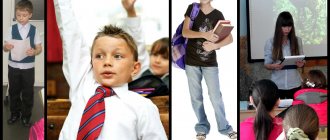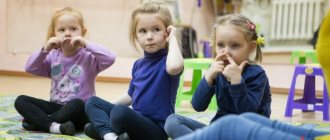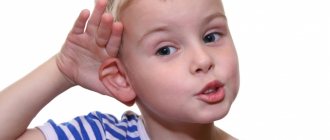Formation of dialogical speech in preschool children
Dialogue is an exchange of remarks between interlocutors. Without dialogical skills, the cognitive process is impossible, and the assimilation of social norms becomes difficult. The development of speech understanding and dialogue building skills are necessarily taught, starting from the younger groups of preschool educational institutions. Various methods are used for this:
- unprepared dialogue;
- reading literature in which characters communicate with each other;
- active, role-playing, theatrical games.
Speech development corner in kindergarten
Conversations with elders are especially important. Dialogues in which adults show interest in the child’s stories best develop communication skills. Unlike communication with peers, during which new verbal formations are practically not learned, regular conversations with educators and parents help to learn effective dialogue.
The kindergarten must not only provide knowledge, but also monitor the compliance of the level of development with existing standards. In addition to external diagnostics, which are carried out annually in all preschool educational institutions at the state level, employees are required to conduct end-to-end monitoring. At the end of each lesson, you should ask students questions and record the level of their answers. If difficulties arise in mastering the rules of dialogue, preschool teachers should use different ways to solve the problem: from additional classes to referral to a speech therapist or psychologist.
Basic ways to develop speech
An important component of communication: dialogical speech of preschoolers
Dialogue is not just an exchange of words. During its construction, information is transferred and new knowledge is acquired. The interlocutors perceive each other’s point of view and learn to respect other people’s opinions. All this forms the basis of competent communication.
If dialogical speech is not developed, the child will be limited in the means of communication. He will not be able to ask a question, ask for help, or answer the teacher’s questions. Interpersonal relationships with parents, classmates, and teachers will suffer greatly.
Dialogue is important not only for building social connections. It underlies communication with teachers and influences the learning of the material. The development of dialogic speech in preschoolers is included in the mandatory preparatory program necessary for entering school.
Additional Information! The norms of the Federal State Educational Standard establish that it is possible to switch to schooling only if you have a competent command of the language.
What skills do preschoolers develop in dialogue?
Researchers argue about what skills develop in dialogue among preschoolers of younger, middle and older ages. Skills may vary depending on age. The following are basic skills for children aged 5 to 7 years.
Games for children 5 years old for speech development and advice for parents
Ability to hear
The child responds to requests, is distracted from his activities to listen to a peer or an adult. He doesn't stop the dialogue mid-sentence or interrupt.
Ability to understand
The preschooler not only listens to the interlocutor, but delves into the meaning of his words. This allows him to choose the right answers, fulfill requests, and continue the dialogue. The child tries to stick to the topic of conversation and not go off into his own thoughts.
Ability to formulate an answer
A preschool education student develops the skill of short and detailed answers. When formulating it, he follows the norms of logic and style, and pays attention to the social status of the interlocutor.
An example of games that help you master the ability to answer
Types of connected speech
Coherent speech is used in two forms - in monologue and dialogic statements.
Dialogue and monologue in coherent speech of preschoolers
When speaking dialogically, you must be able to clearly ask questions in order to prompt the interlocutor to respond with a detailed answer, exclamation or interjection.
If the subject of the conversation is interesting to the interlocutor, then he responds with a remark in order to support and continue the dialogue. During dialogue, disputes, discussions, and defending your point of view are possible.
Monologue speech comes from one person. The subject of the conversation should be clear, and the story should be coherent, logically structured, with the necessary details and emotionally charged. Or the monologue risks turning into a monotonous presentation.
It is extremely rare in everyday communication, but preschoolers need to be taught these skills. Monologues are narrative: a simple story about a sequence of events, usually with verbs and adjectives).
The reasoning monologue contains cause-and-effect relationships, explanatory structures, etc. Confessional monologues represent a symbiosis of narration and reasoning). Internal monologue is a daily reflection that a person builds in his thoughts.
Monologue is organizational speech. For a person to present it competently, it is necessary to build in his head a rough outline of his narrative. And in professions such as a lecturer or teacher, plans are laid out on paper or in digital format.
The speech of a preschooler, as a rule, is spontaneous and situational. It is not planned, but is formed in the course of the statement, is influenced and influenced by the communicative connections between members of society, from the thematic focus of the conversation, from the degree of involvement in the subject of the conversation.
Speech development in preschool age within the framework of psychology and speech therapy
The development of dialogic speech in preschool children is studied not only within the framework of pedagogical activities. This issue is given attention in abstracts on psychology, speech therapy,
Norms of speech development for preschoolers by age
Teacher speech therapist O. A. Poltavskaya, based on research and diploma work in the field of education and psychology, identifies several periods of speech development. Each has its own standards, on the basis of which a teaching plan in a preschool educational institution is drawn up. Next, we will consider the stages from 9 months to 7 years.
Preparatory
From 9 months the child begins to learn the first words. Speech uses simple sounds: a, m, b, i, u. By 12 months, the vocabulary includes from 2 to 10 words.
Early
Stage from 1 to 3 years. The child begins to actively imitate adults, trying to repeat words after them. At first, most sounds are distorted. The first sentences are completed by 1.5 years, at the same age the vocabulary should already be about 100 pieces. At 2 years of age, the range of pronounced sounds expands significantly: k, g, f, o, and soft consonants appear. Sounds such as soft l, e, th are used from 3 years of age. By the end of the early stage, the preschooler should be able to compose complex sentences using conjunctions.
Preschool
Speech development of preschool children from 3 to 6 years. Vocabulary expands to 3000 units. The sounds are fully mastered: by the age of 4 - s, ts, z, by 5 - hissing, r. Pronunciation deficiencies are considered normal until the age of 7 years. If the incorrect sound of r or other sounds persists by grade 1, you should contact a speech therapist.
Important! Deviations from the listed norms may indicate mental retardation, general delay in speech development, or cerebral palsy.
Speech as part of the child’s overall development
Speech development contributes to overall personal growth. Mastering your native language, first of all, helps to establish communication. Correctly built connections with peers and adults ensure social adaptation and assimilation of social norms. It is no coincidence that children with ODD, who lag behind their peers only in terms of language acquisition, even after successful therapy often show aggression, shyness, and cannot find friends.
The place of speech in the general sensitive development of the child
Oral speech is the basis of mental activity. Coursework and serious scientific research show that children with a rich vocabulary master arithmetic, reading, and writing better. They show more motivation while learning new subjects.
Speech development in the younger group - norms for children's speech development by spring
If insufficient attention is paid to speech development in preschool age, the child will face problems not only when learning at the next level, but also in other areas of life.
Techniques for developing coherent speech
There are three methods for developing coherent speech.
- Verbal - a speech sample, an instruction, an explanation, a question - everything that can be used by a teacher for imitation. The main thing is accessibility in form and content. It is necessary to pronounce assignments or samples loudly and clearly, especially in younger groups. Repetition is appropriate for both adults and children. Also in this technique it would be good to use questions: leading and clarifying.
- Visual. The use of didactic material and illustrations, demonstration of articulatory gymnastics, observation of the speech apparatus, when teaching correct pronunciation.
- Combined. Most often, combined methods and techniques are used to improve the results of teaching coherent speech.
Based on the practice of speech therapists and educators, there are several specific techniques that successfully help develop coherent speech.
Speech requirements for kindergarten teachers
High demands are placed on the speech of preschool teachers. The teacher must not only correctly express his thoughts and follow literary norms, but also be able to build a dialogue in accordance with the level of development of the students. Basic requirements that an employee’s oral speech must meet:
- Right. Following the norms of the language.
- Accuracy. Using words in the correct meaning.
- Logic. Proper use of intratextual communication.
- Purity. Absence of non-literary words and expressions.
- Expressiveness. Mastery of intonation, pitch, strength and volume of voice to attract students' attention.
- Wealth. Imagery of speech, wide vocabulary.
- Relevance. Correspondence of speech style to the current situation.
Teachers' council dedicated to teaching dialogue in preschool educational institutions
If there are deviations from the listed requirements, the teacher should improve his speech through self-education or advanced training. To eliminate errors, presentations for teaching councils are also used, containing control tests and instructions for educators.
Techniques for developing coherent speech in preschoolers
The sensitive period in the development of coherent speech is preschool age. The main method used by teachers is visual. These are excursions, looking at objects, toys, paintings, photographs, and writing stories based on them.
This method expands vocabulary and consolidates knowledge of concepts. The verbal method is used a little less frequently among preschoolers; it is based on composing a story without an object or picture, or retelling.
The practical method further develops and improves coherent speech skills. These can be didactic games, any theatrical activity - dramatizations, sketches, round dances, dramatizations, pantomimes.
Development of coherent speech based on pictures
To develop coherent speech more effectively, teachers actively use pictures and illustrations. Children write descriptive stories and are given an algorithm. They are taught to identify the essential features of an object or its main part (Girl with pigtails with bright bows on them.
Detailed description of hair color, bows, etc.) Offers synonyms, comparisons and figures of speech that will more accurately describe the picture.
The result is a competent story-description. The mental work of a preschooler is important here. After all, you must first highlight the most important thing, endow it with signs and properties, and remember something from personal experience about the same subject.
The teacher needs to set an example on his own behalf, on behalf of the toy that came to visit the children. Activities with an adult and children in groups with each other are welcome.
Forming coherent speech by writing stories
Coherent speech successfully develops in the process of the child’s creative activity.
Let’s make a reservation right away - children love to compose. Just look at the words they invented. The task of adults is to direct the gift of writing in the right direction.
Suggest a topic, tell what new phrases can be used. This method is suitable for introducing new words into a child’s speech.
You can introduce the basic literary techniques of famous storytellers. Find out together that there are fantastic or fairy-tale stories, and there are stories from life. In such essays, a child can humanize any character and endow him with various qualities.
Offer to come up with a different ending for the most interesting story.









